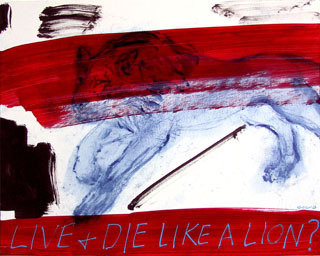Leon Golub
dal 20/1/2011 al 24/4/2011
Segnalato da
20/1/2011
Leon Golub
Museum Het Domein, Sittard
The exhibition features about fifty drawings that Golub completed between 1999 up until his death in 2004. The later drawings demonstrate a stylistic and thematic shift away from a long-term preoccupation with the atrocities of the external world towards an exploration of the personally revelatory.

The American artist Leon Golub (1922-2004) with his extremely engaged work acquired—like his wife Nancy Spero—a reputation as a preeminent "artist's artist" and as the moral conscience of the art world. The exhibition, Live & Die Like a Lion?, is the first solo exhibition of Golub's work in the Netherlands and features about fifty drawings that Golub completed between 1999 up until his death in 2004. Although Golub is primarily known as a painter, drawing was the foundation of his artistic practice. The later drawings demonstrate a stylistic and thematic shift away from a long-term preoccupation with the atrocities of the external world towards an exploration of the personally revelatory. Scenes of human mortality alternate with explicitly erotic depictions; political indictments with wry humor and subversive texts. The drawings are stirring in their directness and newfound freedom. This exhibition marks the first time that attention has been devoted to Golub's late drawings on such a large scale.
With their intimate formats, Golub's late drawings stand in sharp contrast with his infamously meters long paintings. In the 1950s he gained recognition for strongly expressive paintings featuring fighting figures inspired by art brut and existentialism. During the heyday of minimal and conceptual art, Golub continued painting and created highly political works, including pieces in opposition to the Vietnam War. The painting techniques that Golub used in the late paintings reflect the often controversial choice of subject matter. He scraped the painted canvases with butcher knives, re-exposing sections of the raw linen, and then nailed them directly to the walls without canvas stretchers as if they were protest posters. In the 1970s, he created primarily portraits of dictators and influential industrialists. From the 1980s, in series like Mercenaries, Interrogation and Riot, Golub focused on all kinds of forms of power abuse and violence—from American interventions in Central America to street violence and rough police interrogations.
The exhibition is curated by Brett Littman, Executive Director, The Drawing Center, New York, and is made possible by the National Endowment for the Arts and the Dedalus Foundation. Generous funding for the catalogue has been provided by Ronald Feldman Fine Arts, Peter Frey and Caroline Shapiro.
On Sunday 23 January at 3 p.m., Drawing Center director and exhibition organizer Brett Littman will give a lecture on the show. For more information, please visit www.hetdomein.nl.
The exhibition will be accompanied by a catalog.
Concurrently the exhibtion Hans Op de Beeck. Extensions is also on view at Museum Het Domein.
Press contact
Karin Adams or Roel Arkesteijn. Tel. +31 46 4513460; karin.adams@hetdomein.nl, roel.arkesteijn@hetdomein.nl.
Opening Friday January 21, 5 pm
Museum Het Domein
Kapittelstraat 6 Postbus 230 NL-6130 AE Sittard
Hours: Tuesday through Sunday from 11 am till 5 pm
Admission: Adults € 6,00
Discount cards € 4,00
Groups of a minimum of 15 persons € 5,00
Free admission Youngsters up to 18 years, people with a Museumjaarkaart, Friends of Het Domein and everybody on the first sunday of the month



